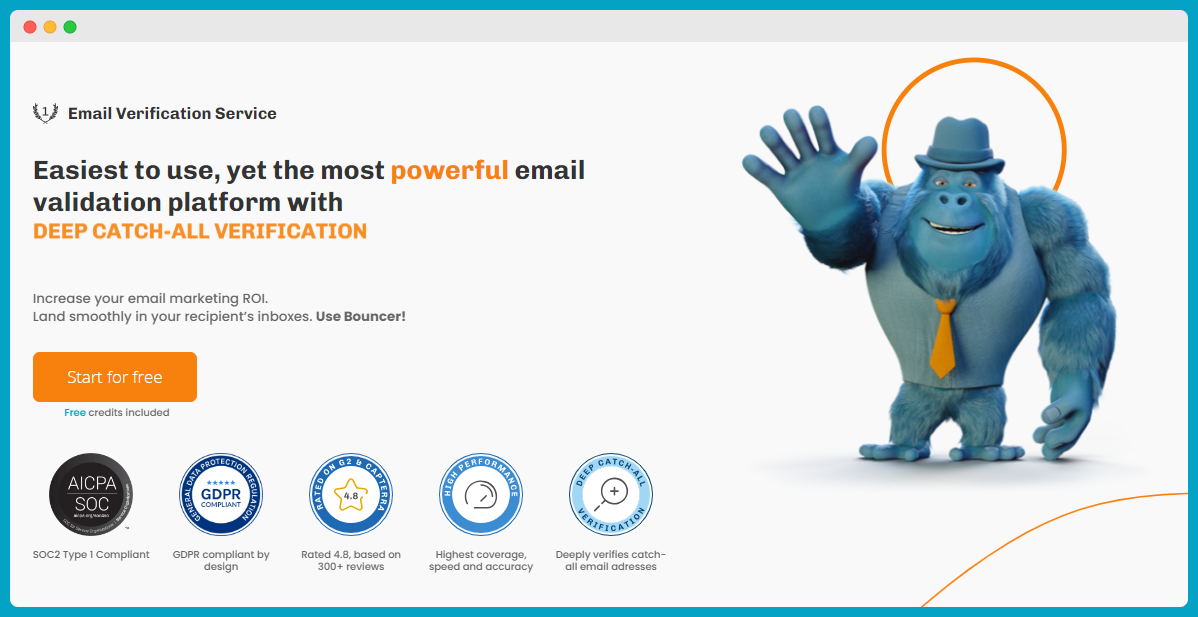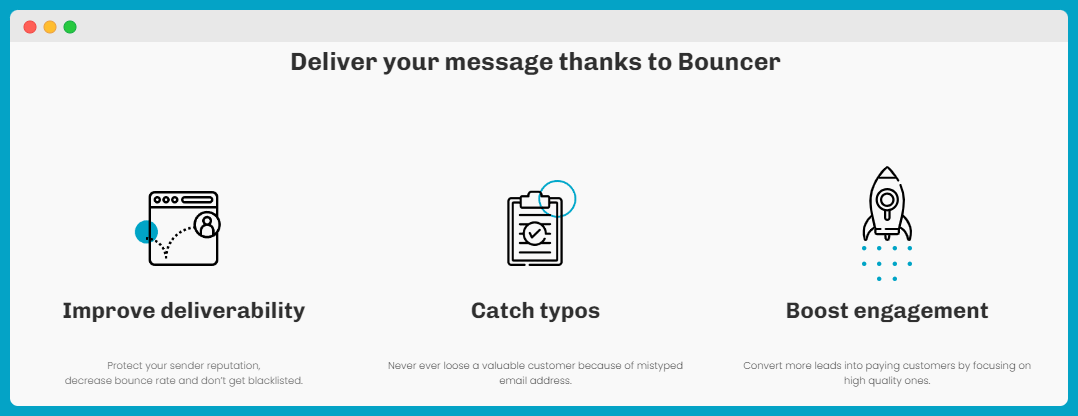If you’re in the email marketing game, you’ve probably heard the term ‘spam trap’.
These sneaky email addresses can cause a world of trouble for your campaigns and email reputation.
But don’t sweat it just yet.
We’re going to walk you through the ins and outs of spam traps, as well as how to keep your email lists clean and effective.
What is a spam trap?

A spam trap is basically a fake email address that internet service providers use to catch junk email. It’s not a real person’s email, but it’s out there to see who’s sending spam.
At Bouncer, we believe that spam traps are important artifacts of the email ecosystem, playing a big role in fighting spam, phishing attacks, and scams.
Most commonly, spam traps are used against people who scrape websites to capture all of the addresses from them. For example, they scrape 100 email addresses and within them, you hide an address that goes like this: contact@example.com. Usually, you’ll hide it in a way that it’s invisible to a human’s eye to make sure that no real person will spot it, but the scraping robot will store it anyway.
This address is a spam trap and serves to catch people who want to send spam. The moment someone sends an email to this address, your email service provider labels them as a spammer.
Even if you’re sending great emails for the right reasons, you could still hit a spam trap by accident. It’s like mistyping an email address. But, instead of getting a ‘user not found’ message, you get flagged for spam.
To avoid this, you need to keep your email list up-to-date and make sure you’re not sending emails to these traps. It’s a bit like double-checking your contacts before hitting send. This way, your emails stay out of the spam folder and reach real people instead.
What are the main types of spam traps?
Businesses and anti-spam organizations are pretty serious about catching unwanted emails.
They use spam traps, which are like secret tests to see if you’re sending emails where you shouldn’t.
Let’s talk about the main types so you can steer clear of them:
Pristine spam traps
These are email addresses created just to identify spam traps. They’re never used for anything else – no sending, no receiving, just trap-setting in your contact lists.
If you send an email to one of these pristine traps, it’s a big red flag. It’s like accidentally walking into a security alarm – it’ll go off, and your sender reputation could take a hit.
Your emails might start going straight to the spam folder, which is a nightmare for anyone who relies on email to reach customers.
Avoiding pristine spam traps is all about keeping your email list clean and updated.
Treat it as making sure you have the right phone numbers in your contacts – you don’t want to call the wrong number, especially one that could get you in danger.
Recycled spam traps
Recycled spam traps aren’t as tricky as pristine ones, but they’re still a headache for your email program.
Recycled traps are usually old email addresses that used to be valid but aren’t anymore.
Think of emails that have typos or domains with mistakes—like ‘yaho.com‘ instead of ‘yahoo.com‘. They might have belonged to someone who left a company or just got abandoned.
Hitting a recycled spam trap generally isn’t as bad as hitting a pristine one, but it’s still a problem.
It can make you look like you’re not careful with your email list, which can hurt your email reputation over time.
Why it’s important to avoid spam traps
It’s crucial to stay away from spam traps because they can seriously mess up your email deliverability. If you want to prevent deliverability issues and protect your email reputation, you need to ensure that each contact in your list is a real email address.
When you hit a spam trap, it signals to email providers that you might be a spammer. As a result, your emails could end up flagged as spam, which means they won’t reach your intended audience.
This can damage your sender reputation and make it harder for all your emails to get through, not just the ones that hit the traps. Many recipients may consider your content as spam emails or unsolicited emails, and this can last for a long period of time before blocklist providers remove you from their list.
Keeping your email list clean and updated is the best way to avoid these traps and ensure your messages land in the right inboxes.
How to avoid spam traps in email marketing efforts

To keep out of trouble with both pristine and recycled spam traps, you need to be on top of avoiding spam traps from your list.
Here’s how:
#1 Don’t buy email lists
First things first, buying email lists is a no-go. You want to ensure each email is a real subscriber that said yes to receiving content from you.
We know it’s tempting to get a bunch of email addresses in one go, but it’s a pretty dangerous practice.
You might get a bunch of potential spam traps, and that’s asking for trouble. It’s always better to grow your list organically and from scratch.
#2 Don’t scrape email lists from websites
Next up, scraping email lists from websites might seem like a clever shortcut, but it’s one you take to disaster. If you collect emails on your website, you can prevent spam traps by using double opt-in. Double opt-in prevents your contact lists from being flooded with invalid emails.
These lists can be full of spam trap email addresses just waiting to catch spammers. And you don’t want to be caught in that net, right?
#3 Validate your email lists regularly and keep a pristine email list hygiene
You should regularly validate your email lists. It’s like checking your fruits and veggies before you buy them – you don’t want any rotten tomatoes = spam trap addresses.
Thanks to validating, you’re making sure you don’t have any invalid email addresses or, worse, typo spam traps.
Those are tricky because they look like real addresses but are just misspelled. And just like that, you could be sending emails into the void – or straight to a spam trap.
Validating helps in removing spam traps from your list, keeping your sender reputation shiny and your emails landing right in the inbox, where they belong.
How to remove spam traps
Let’s get down to business and clean up that email marketing list of yours.
Bouncer will help you with that, but keep in mind that the tool won’t fully protect you from spam traps, as they’re hard to detect – the really good ones are not publicly known. Spam traps that work are hardly detectable, and if they are, they are probably not in use anymore.
Actually, we prefer to provide information about the toxicity of email addresses. The higher Toxicity Score is, the higher probability of hitting a spamtrap or other malicious and harmful email address.
Validation helps a lot, so why not take advantage of it?
Plus, there’s more than just spam traps – outdated emails, typo-filled addresses, you name it.
Here’s a super straightforward way to do it.
Take your email list and upload it to Bouncer
First off, grab your email list and let Bouncer be your partner.
You can either upload your list directly to Bouncer or, if you’ve got a favorite Email Service Provider (ESP), you can integrate it with Bouncer. Easy peasy.
|
What is Bouncer? Bouncer is an email verification and deliverability platform designed to improve email marketing ROI by ensuring emails land in recipients’ inboxes. It offers services such as real-time and bulk email verification, toxicity checks to identify harmful email addresses, and deliverability kits to test inbox placement and monitor blocklists. Bouncer is GDPR compliant and emphasizes security, accuracy, and customer support. |
Validate your email list with Bouncer
Once you’ve got your list where it needs to be, hit the ‘validate’ button and let Bouncer work its magic. It’s going to sift through your list, checking each email like a detective looking for clues.

Analyze your results and remove all invalid addresses from your lists
After Bouncer’s done, take a look at your results.
You’ll see which addresses are good to go and which ones are no-gos.
And we’re not just talking about spam traps here – this includes those old, outdated emails and the ones that have typos. You know, the kind where ‘gmail’ is spelled as ‘gmial’ instead.
In just these 3 simple steps, you may avoid spam traps.
Boost your email marketing with Bouncer
Helping you with spam traps isn’t our only superpower.
Bouncer offers a suite of tools to make your email marketing campaigns as efficient and effective as possible.
Here’s how we can further enhance your email strategy:
- Email list verification – clean your email lists with Bouncer’s reliable email checker. This user-friendly tool helps maintain communication and reach out to real people with ease and promptness.
- Real-time & bulk email verification API – with an ultrafast and easy-to-integrate API, Bouncer provides limitless possibilities to validate emails in real-time or clean whole batches at once.
- Toxicity Check – identify toxic email addresses in your list, such as those widely circulated, breached, belonging to complainers, or potential spam traps.
- Deliverability Kit – test your inbox placement, verify your authentication, and monitor blocklists to ensure your message reaches the inbox.
Bouncer is not just powerful and reliable – it’s also very budget-friendly. With Bouncer, you get:
- Premium support – access to truly caring people ready to assist you, whether you’re a small business or a large enterprise.
- High coverage – Bouncer’s deep catch-all verification means you won’t miss a single valid email address.
- Top-notch accuracy – with our solution, you can expect rocket-fast speed and the highest accuracy in email verification.
- Security – we provide fortress-like security to protect your data.
Our satisfied customers and their testimonials speak volumes about the effectiveness of Bouncer.
Here’s what some of them have to say:
“ Finally, a verification platform that covers all aspects accurately… The accuracy is by far the best.” – Damien F., Head Of Business Development
“ A great email verification tool!… numerous features such as deliverability test and toxicity test, things you won’t find in most of the competitors!” – Lucas M., Growth Specialist
“ It’s easy to use and does the job. My bounce rate is lower than ever before.” – Kacper B., Information Technology and Services
With thousands of happy customers and amazing ratings from verified users, Bouncer is the go-to tool for businesses looking to protect their sender reputation and boost overall email marketing.
Start for free and see for yourself why Bouncer is a favorite in the email verification space.

Conclusion
Remember, keeping your email list free of spam traps isn’t just about avoiding trouble – it’s about connecting with real people who genuinely want to hear from you.
Use tools like Bouncer to clean your list, stay vigilant, and make your email marketing really pop.
Keep it clean, keep it honest, and you’ll keep your emails out of the spam folder.
And a little quote for the end:
“Not all spam traps are dangerous – only those you don’t avoid!” 😉


